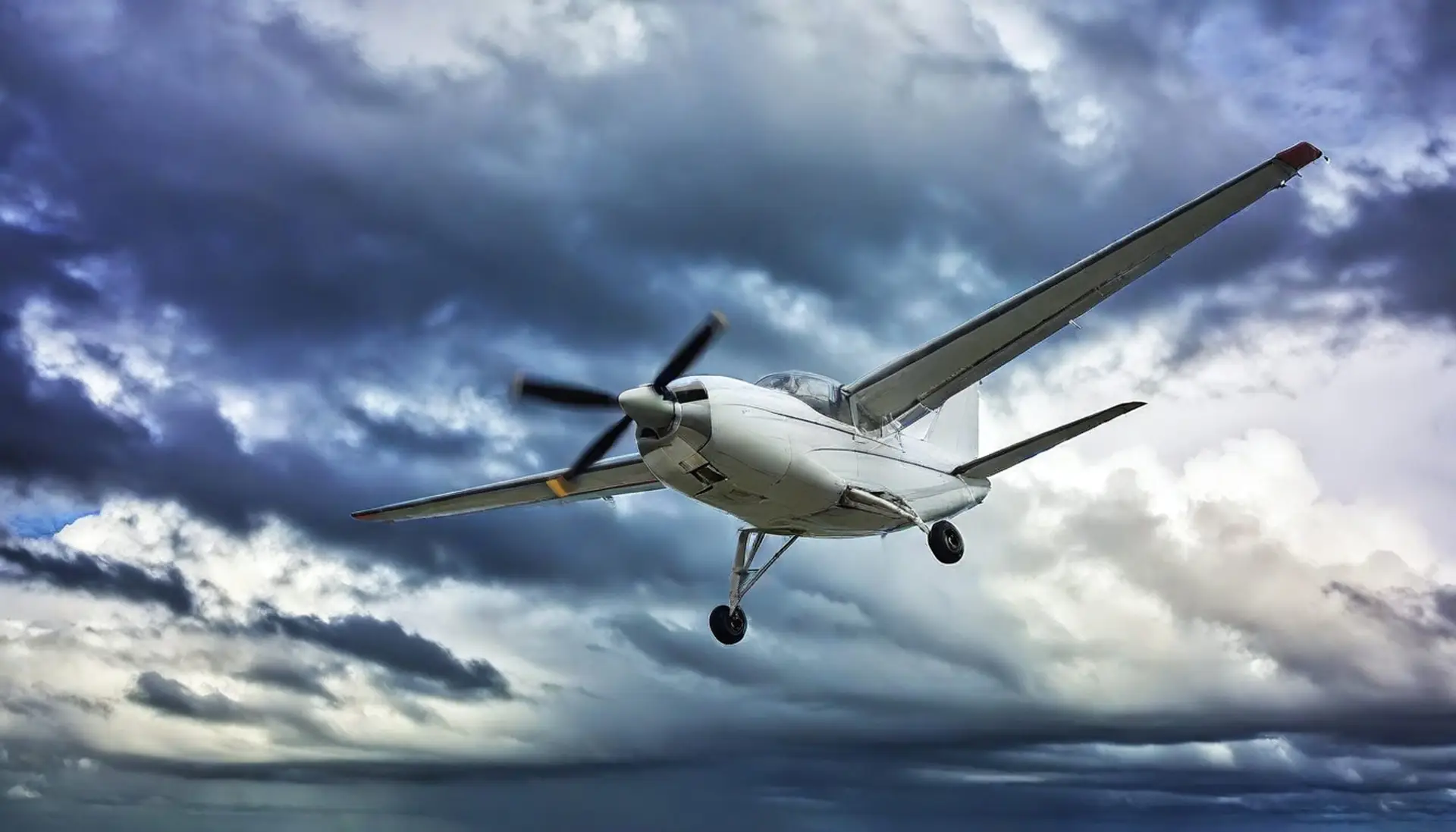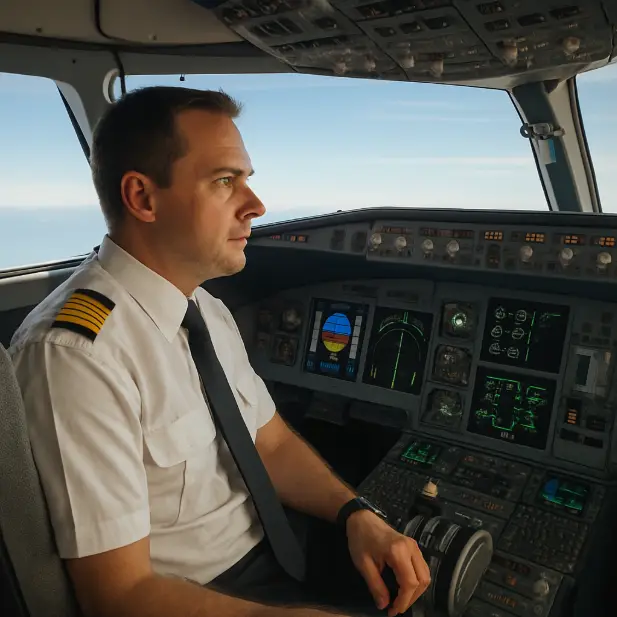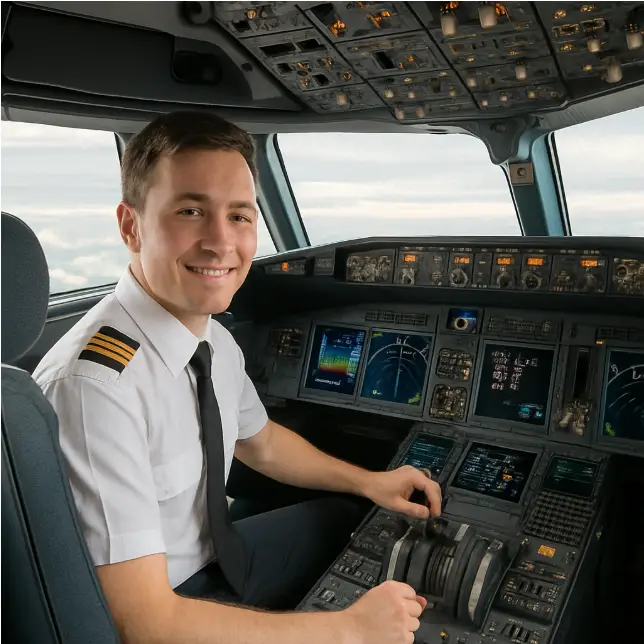How Weather Impacts Your Flight Training in the real world

- aviatorpro_6714
Weather plays a pivotal role in aviation. It can affect the safety, scheduling, and overall experience of flight training. From clear skies to thunderstorms, each weather condition presents unique challenges and learning opportunities for aspiring pilots. Understanding the fundamental relationship between weather and flight is essential for anyone looking to become a proficient pilot. Weather conditions can dictate the type of training conducted, the skills emphasized, and the decision-making processes required. It is this dynamic interplay between weather and flight that makes pilot training both challenging and rewarding.
Types of Weather Conditions
- Clear Skies: Ideal for beginners, clear skies offer stable conditions, making it easier to focus on basic maneuvers and controls. These conditions are often preferred for initial flight lessons, allowing students to concentrate on learning the aircraft’s systems and handling. The lack of weather-related distractions helps new pilots build confidence as they master foundational flying techniques. Moreover, clear skies provide an opportunity for instructors to introduce complex concepts gradually, ensuring that students are not overwhelmed.
- Cloudy Skies: While clouds might seem harmless, they can obscure visibility, requiring pilots to rely more on instruments. This reliance is a critical skill that pilots must develop, as clouds can also lead to disorientation if visual references are lost. Training in cloudy conditions helps students become comfortable with instrument flying, a necessary competency for any pilot. Additionally, navigating through clouds introduces pilots to the concept of spatial awareness, which is essential for maintaining control of the aircraft.
- Rain: Rain can affect visibility and aircraft performance. It demands more attention from pilots to maintain control and ensure safety. The presence of rain introduces additional factors such as hydroplaning and reduced braking efficiency, which pilots must learn to manage. Training in rain conditions also emphasizes the importance of pre-flight checks and understanding how moisture can impact an aircraft’s systems. Furthermore, rain provides an opportunity to practice decision-making skills, such as when to proceed with or delay a flight.
- Wind: Wind is a double-edged sword in flight training. While it can aid in lift, strong winds can make maneuvers challenging. Pilots must learn to adjust their techniques to compensate for wind effects, such as crosswind takeoffs and landings. Training in windy conditions helps pilots develop a deeper understanding of aerodynamics and the forces acting on an aircraft. Additionally, pilots learn to anticipate changes in wind patterns and adjust their flight plans accordingly, enhancing their overall situational awareness.
- Thunderstorms: Known for their unpredictability, thunderstorms are best avoided. They can cause turbulence, lightning, and even hail, posing significant risks to flight safety. However, the presence of thunderstorms provides a valuable lesson in weather avoidance and risk assessment. Pilots learn to identify signs of developing storms and make informed decisions to ensure safety. Training includes understanding the limitations of flying near thunderstorms and recognizing when to divert or postpone a flight.
How Weather Impacts Flight Training
Visibility Challenges
Visibility is paramount in aviation. Weather conditions like fog, rain, and snow can severely limit a pilot’s line of sight. Reduced visibility requires pilots to rely more on their instruments, a skill that is essential for safe flying but can be daunting for beginners. Learning to navigate with limited visibility is a crucial part of flight training, helping pilots build confidence in their ability to manage challenging conditions. Moreover, visibility challenges emphasize the importance of communication with air traffic control, as pilots may need additional guidance when visual references are obscured.
Training in low-visibility conditions also teaches pilots to trust their instruments, a fundamental aspect of flying. Instrument proficiency enables pilots to maintain control and navigate accurately, even when external cues are absent. This skill becomes particularly important during approaches and landings, where precise control and situational awareness are critical. As pilots progress in their training, they develop the ability to seamlessly transition between visual and instrument flying, ensuring safety and efficiency in all weather conditions.
Turbulence and Aircraft Control
Turbulence, often caused by changes in wind speed and direction, can make flying uncomfortable and challenging. It requires pilots to have a firm grasp of aircraft control to maintain a steady flight path. Training in turbulent conditions helps pilots build confidence and adaptability. These experiences teach pilots to anticipate and respond to sudden changes in the aircraft’s behavior, improving their overall handling skills.
Additionally, turbulence training emphasizes the importance of passenger comfort and communication. Pilots learn techniques to minimize the effects of turbulence on passengers, such as adjusting altitude or speed. Understanding how to manage turbulence also involves recognizing the different types, such as clear-air turbulence and mechanical turbulence, and knowing the appropriate responses for each. This comprehensive approach ensures that pilots are well-equipped to handle turbulence safely and effectively.
Decision-Making and Risk Assessment
Weather impacts the decision-making process in flight training. Pilots must learn to assess risks and make informed decisions based on weather forecasts and real-time conditions. This includes deciding when to postpone a flight due to adverse weather. Developing strong decision-making skills is essential for pilots, as they often face situations where they must weigh the risks and benefits of continuing or altering a flight.
Risk assessment training involves understanding the limitations of both the aircraft and the pilot. Pilots learn to evaluate their own comfort levels and experience, as well as the aircraft’s capabilities, to make sound judgments. Additionally, pilots are trained to recognize when external pressures, such as scheduling or passenger demands, might influence their decision-making. By prioritizing safety, pilots develop the confidence and competence to make the right choices in challenging weather conditions.
Instrument Training
Adverse weather conditions necessitate training with instruments. Instrument training is crucial for navigating through clouds and low-visibility situations. Pilots learn to trust their instruments and hone their skills in flying without visual references. This training is essential for obtaining an instrument rating, which allows pilots to fly in a wider range of weather conditions and enhances their overall proficiency.
Instrument training also involves understanding the various systems and indicators used in modern aircraft. Pilots become adept at interpreting data from altimeters, attitude indicators, and navigation systems, ensuring accurate and safe flight paths. Additionally, instrument training includes practicing emergency procedures, such as responding to instrument failures, to prepare pilots for unforeseen situations. By mastering these skills, pilots gain the confidence to navigate any weather challenges they may encounter.
Adapting to Weather Conditions
Pre-Flight Planning
Effective pre-flight planning is essential for safe flying. This includes checking weather forecasts, understanding potential changes, and planning alternative routes if necessary. Thorough planning helps pilots anticipate weather-related challenges and prepare accordingly. Pilots are trained to use a variety of resources, such as weather briefings and online tools, to gather comprehensive information before a flight.
Pre-flight planning also involves considering the impact of weather on fuel consumption, flight time, and aircraft performance. Pilots learn to assess whether additional fuel or alternative airports may be needed due to changing weather conditions. By developing robust planning skills, pilots ensure they are ready to adapt to any weather-related challenges they may face during their flights.
Utilizing Technology
Modern technology provides pilots with tools to better understand and navigate weather conditions. Weather apps, radar systems, and onboard instruments offer real-time data, helping pilots make informed decisions. These technologies enhance situational awareness, allowing pilots to monitor changing weather patterns and adjust their flight plans as necessary.
Utilizing technology also involves understanding the limitations and capabilities of these tools. Pilots are trained to interpret radar images, analyze satellite data, and use advanced weather prediction models to gain a comprehensive understanding of weather conditions. By integrating technology into their flight operations, pilots can enhance safety and efficiency, ensuring successful navigation through diverse weather scenarios.
Continuous Learning and Adaptation
Flight training is an ongoing learning process. Pilots must continually adapt to changing weather conditions and build their experience. Each flight offers a new set of challenges and learning opportunities, enhancing a pilot’s skill set over time. This continuous learning approach encourages pilots to remain engaged and proactive in their training.
Adapting to weather conditions also involves seeking feedback from instructors and peers. Pilots benefit from sharing experiences and learning from others who have faced similar weather challenges. This collaborative learning environment fosters a culture of safety and innovation, empowering pilots to develop creative solutions to weather-related issues. By embracing continuous learning, pilots can stay ahead of evolving weather patterns and maintain their proficiency in all conditions.
Real-World Examples of Weather Impacts
Case Study 1: Navigating Through Fog
A student pilot was scheduled for a cross-country flight. However, upon reaching the destination, they encountered unexpected fog. Utilizing their instrument training, they relied on the aircraft’s navigation systems to safely complete the flight, reinforcing the importance of instrument proficiency in low-visibility conditions. This experience highlighted the necessity of pre-flight planning and the ability to adapt to changing weather conditions.
The pilot’s ability to remain calm and focused in the face of reduced visibility was a testament to their training. By trusting their instruments and maintaining communication with air traffic control, they successfully navigated to their destination. This case study underscores the importance of instrument training and the confidence it instills in pilots, enabling them to handle unexpected weather challenges with poise and professionalism.
Case Study 2: Handling Crosswinds
A flight training session took place on a day with strong crosswinds. The student pilot struggled initially with maintaining the aircraft’s direction during takeoff. Through practice and guidance from the instructor, they learned techniques to counteract the wind, such as using rudder input and adjusting the control surfaces. This hands-on experience was invaluable in developing the pilot’s skills and confidence.
The instructor’s role in providing real-time feedback and encouragement was crucial to the student’s success. By breaking down the components of a crosswind takeoff and landing, the instructor helped the student build a solid foundation for handling challenging wind conditions. This case study illustrates the importance of practical experience and mentorship in flight training, as pilots learn to navigate the complexities of real-world weather scenarios.
Case Study 3: Thunderstorm Evasion
During a training flight, a pilot noticed a developing thunderstorm on the radar. Recognizing the potential danger, they made the decision to alter their course and avoid the storm, demonstrating the critical skill of weather avoidance and decision-making. This proactive approach ensured the safety of the flight and reinforced the importance of situational awareness.
The pilot’s ability to interpret radar data and make a timely decision was a reflection of their comprehensive training. By prioritizing safety and adhering to established protocols, they successfully navigated around the storm. This case study emphasizes the importance of weather awareness and the role it plays in effective decision-making, as pilots learn to anticipate and mitigate potential risks.
The Importance of Weather Awareness in Pilot Training
Understanding and adapting to weather conditions are fundamental aspects of flight training. Weather impacts not only the technical skills of flying but also the decision-making and risk management abilities of a pilot. By embracing the challenges posed by weather, pilots can enhance their proficiency and confidence in the skies. This comprehensive understanding of weather dynamics is essential for pilots to navigate diverse conditions safely and effectively.
Weather awareness also fosters a culture of safety and continuous improvement within the aviation community. Pilots learn to approach weather challenges with a proactive mindset, seeking to expand their knowledge and skills. By prioritizing weather awareness in training programs, flight schools ensure that pilots are well-prepared to handle any weather-related challenges they may encounter, ultimately enhancing the overall safety and success of their flying careers.
Conclusion
Weather is an integral part of flight training, influencing every aspect of the pilot experience. From clear skies to thunderstorms, each condition offers unique challenges and learning opportunities. By understanding how weather impacts flight training, aspiring pilots can better prepare themselves for the realities of flying and develop the skills needed to navigate the skies safely. Weather awareness is a critical component of pilot training, equipping pilots with the tools and knowledge to succeed in any environment.
Incorporating weather awareness into training programs ensures that pilots are equipped to handle diverse conditions, making them more competent and confident in their flying abilities. Embrace the weather, learn from it, and let it guide you to becoming a skilled pilot. By doing so, pilots not only enhance their technical abilities but also contribute to a safer and more resilient aviation community.



